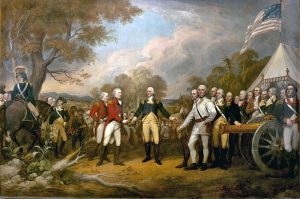 This 18th Century Dagger is made of steel and wood. It has been preserved in the collections of the Old Stone Fort Museum and Schoharie County Historical Society complete with its original leather sheath.
This 18th Century Dagger is made of steel and wood. It has been preserved in the collections of the Old Stone Fort Museum and Schoharie County Historical Society complete with its original leather sheath.
The dagger was used during the Revolutionary War and was purported to have been taken from a Tory or Loyalist soldier by David Ellerson at the pivotal Battle of Saratoga.
David Ellerson was a member of the elite light infantry unit commanded by General Daniel Morgan during the American Revolutionary War known as “Morgan’s Riflemen. Members of Morgan’s Riflemen specialized in long range precision targeting and assassinations. They used new rifles instead of muskets making them lethal and effective snipers.

In addition to using their longer range capabilities to slow the retreat of Colonel William Howe through New Jersey and other engagements, Morgan’s Riflemen played a key role in the Battle of Saratoga. It is even suggested that it was a member of Morgan’s Riflemen (specifically Timothy Murphy) who shot and mortally wounded British General Simon Fraser at the Battle of Bemis Heights during the Saratoga Campaign, ultimately turning the tide of the battle and eventually the entire war.
Murphy and Ellerson, in addition to both being members of the elite rifle corps, were known to be good friends and some believe it was actually Ellerson’s superior rifle which Murphy would have used to take the fatal shot.
The collections at the Old Stone Fort and Schoharie County Historical Society contain numerous artifacts which belonged to both men, including their rifles, personal items and this dagger.
The dagger was presented to the historical society by William Henry Becker, a direct descendent of David Ellerson.